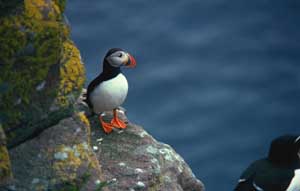|
|
 35 sea birds DHJanzen101158.jpg high resolution
|
|
| This puffin is symbolic of an other arctic phenomenon just touched on here. In general terms, nutrient-rich waters from the depths of the oceans circulate to the poles where they surface - and support enormous quantities of marine microorganisms and minute crustaceans which in turn support large and complex food chains of fishes and larger invertebrates. These in turn support(ed) a large biomass of marine birds and mammals. This puffin, and many tens of other species of cliff-nesting birds, reach(ed) by far their largest biomass on the earth in these northern waters and in their southern analogues (with penguins being the best known, along with whales and seals). By way of contrast, vast areas of tropical oceans do not, and never did, sustain marine bird and mammal biomass even slightly comparable to the arctic/antarctic. There are (were) only a couple of species of tropical seals, each so rare that their extinction in most places was preordained as soon as humans were turned loose on them. The northern sea cliffs covered with millions of fish- and crustacean-eating bird nests have no counterpart over tropical warm waters (and the shoulder-to-shoulder nesting colonies on some tropical oceanic islands are supported by bird flights over many hundreds of thousands of square miles of ocean foraging and migration). | ||
back to lecture slides
or skip to: